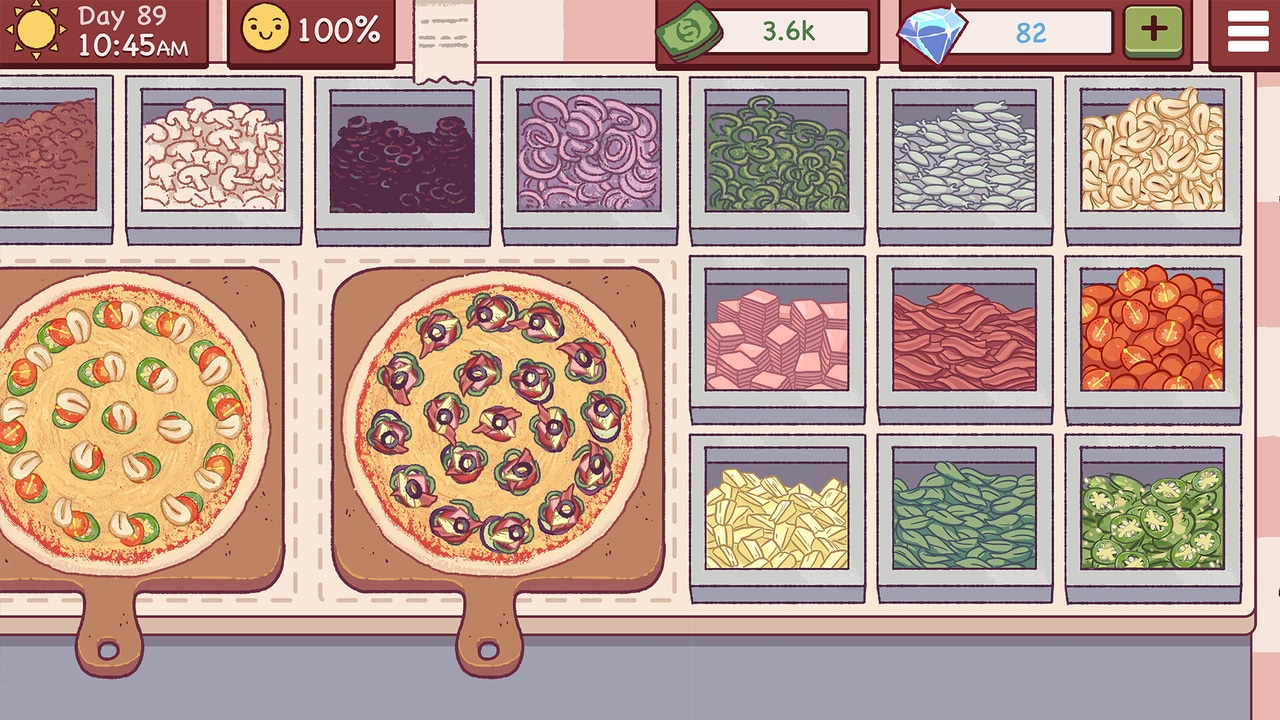Trending
Opinion: How will Project 2025 impact game developers?
The Heritage Foundation's manifesto for the possible next administration could do great harm to many, including large portions of the game development community.

| Dig in! Exploring Cooking Mechanics in Games | ||
| Every day this week, Game Developer is serving up a feast of interviews, deep dives, and more digging into the evolution of Cooking in video games. | ||
| Browse Latest Articles | Submit your Blog | |
The creators of this pizza-making title explain how real-life experience from a novice developer shaped the game's design.

Good Pizza, Great Pizza sees players taking a hands-on approach to cooking up tasty-looking pies for the many customers who walk through the doors of their custom pizza shop.
Game Developer sat down with the team at Tapblaze to talk about giving the player the ability to express themselves through pizza-making, the real-world experience and fond memories that helped shape the cooking and shop features, and how they designed systems that could create over a million different pizza orders players could come across.
Good Pizza, Great Pizza sees players serving up pizzas to customers. What interested you about making a game about running your own pizza shop?
Yuni Cho, community marketing manager: Our CEO, Anthony Lai, grew up in Queens, NY, where people from all cultures and walks of life would eat and enjoy pizza as a universal food. One of his fondest childhood memories was going to a by-the-slice pizza shop and visiting the arcade store in his neighborhood, which later became an inspiration for the general “hole in the wall” neighborhood pizzeria mood of Good Pizza, Great Pizza.
We were inspired to make a game with the same global and diverse reach through the eyes of pizza-making. After iterations My Pizza Shop and My Pizza Shop 2, Good Pizza, Great Pizza was finally born. Its unique structure combines a story-driven casual game, a technical business simulator, and a creative pizza-making mechanic.
What thoughts went into designing gameplay around the actual crafting of the pizzas? What appealed to you about creating such a hands-on play style for making the food? What do you feel this hands-on play adds to the experience?
Anthony Lai, CEO and founder of Tapblaze: The initial team were big fans of pizza to begin with. The original artist even worked at Costco Pizza, and we were looking for an artist with a unique style that would appeal to a universal crowd. With the belief in pizza’s global reach and insight into how pizzas were made, we created the design for Good Pizza, Great Pizza.
There is beauty in the art of pizza-making. The dough acts as a canvas for whoever makes it. It’s an empty space where anyone can paint a picture, add their own flair, and express themselves while making an equally delicious pizza. The hands-on play allows players to personalize their experience and satisfyingly adds to the game’s realism. It’s important that a game gives players an opportunity to express themselves, and for us, that was pizza.

Images via TapBlaze.
The food looks pretty tasty as you play through Good Pizza, Great Pizza. What visual design ideas go into making food that looks good? What thoughts go into creating a game that will make players hungry?
Lai: The visual idea was to make players crave the pizza they were making in the game. The unique art style combined with the overall warmer tone of the game enhances the pizzas’ appetizing look. Each topping also goes through multiple concepts internally before they are put into the game. It is the “beauty in the details” that we believe makes the pizza in the game look so delicious.
Cho: Our focus is to keep the realism. Many of the pizza orders you see in the game are based on real pizza orders/menus like Supreme, Veggie, or Meat Lovers. We wanted to draw from the familiarity and nostalgia associated with eating pizza.
Through the game reviews from actual pizza shop employees, we seemed to have really nailed the realism of the customers in particular. Many would write us an app review on how much of a hoot they got out of some outrageous but very realistic customer requests, like no cheese or sauce on a pizza order.
The game’s Steam page mentions that the designer worked in a pizza shop for years and has brought that experience to the game. Can you tell us a bit about how that actual experience shaped the game? Any stories from your working years that made for interesting elements or storylines within the game?
Lai: The original artist worked at Costco Pizza and dreamed of becoming a game artist. But due to his lack of experience, no one had given him a chance. As a new game startup, TapBlaze saw the artist’s potential and considered his pizza-making experience as a bonus for the company.
His real-life experiences ultimately shaped the general feeling of the game. From the art style, color tones, and characters, the game is reminiscent of an “indie” game. Characters, like the fan-favorite hobo customer, often have a backstory where they become someone from nothing, just like our studio and the original game artist.
Cho: We try our best to incorporate slightly modified versions of what we see in our daily lives. The diversity of the game’s characters is reminiscent of the customers our CEO saw when he used to hang out at pizza shops growing up. We also take inspiration from the people we encounter in our day-to-day lives; the mailman in the game is also the mailman who used to come to our office.

Images via TapBlaze.
What thoughts went into the cooking equipment players would use within the game and how they would be able to upgrade it? How did this equipment further capture a realistic pizza shop experience?
Lai: The cooking equipment came from looking up what real-life pizzerias use to cook their pizzas. The pizza oven is based on the ones used in Costco and other pizza chains. The “autobuddy” upgrades available in the game came directly from the idea that Costco saves a lot of money using their auto saucer machine.
It aims to capture a realistic pizza shop experience since everything you see will be exactly like a mom-and-pop pizzeria. The topping bins, pizza peel, pizza boxes, and shop decor should remind players of their local pizza shop. The only difference is the auto buddies that add a game-like mechanic to magically place your toppings in the perfect spots quickly.
You state that there are over one million unique pizza orders possible in the game. What work went into creating so many different orders? How did you accomplish this?
Keyan Zhang, game designer: There are thousands of order strings broken up into four different parts. Essentially, these strings are randomized per pizza order to create an entirely new order from the last order the player came across. It is separated into toppings (with over 20 different ones to choose from), sauces, slice amounts, and additional customizations like double-baked pizza.
When you mix these components together to generate an order, more than a million types of orders could be generated.

Images via TapBlaze.
Players can heavily customize their shops in a variety of ways. Why was this important to the experience to you? What thoughts go into designing neat things players can use to decorate their shops?
Cho: The customizable shop was and still is a very important aspect of the game’s charm. It is the #1 place where players can show off their style and personality, truly making the pizza shop their own. This is evident in the game’s reviews and communities, where players often share their excitement over their decorated shops with many “Rate My Shop” posts. It’s another form of creative expression for players.
The artists are given a theme and different places the decors could go. After that, it’s up to them to create the magic. For example, Halloween 2021’s theme was “goth.” The artists designed a gorgeous table set, blood-red chandeliers, a molded oven, and burgundy “goth” decorations that fit the theme of a vampire’s castle.
You continue to update the game with seasonal events and new content. What thoughts go into adding something fun to pizza-making around specific holidays and seasons? Can you tell us a bit about designing more toppings and items for a specific event you’re particularly proud of?
Lai: First and foremost, we ask: “How can we make this pizza-style?” Whether it’s for Mother’s Day, summer, Halloween, or Christmas, the point is to make everything in the style of the game.
Mary Le, narrative designer at Tapblaze: The most recent topping additions were inspired by how different cultures interpret pizza; some have figs, some have avocados, and others may have duck. We try to widen our players’ perspectives and educate them about the pizzas people eat around the globe. A great way to do that is through new, exciting, and sometimes outlandish ingredients.
Zhang: We are particularly proud of the 2021 summer event, during which we introduced the avocado topping and gardening feature to the game for the first time. It was a great success as players were able to grow their own pizza ingredients, showcasing a true “farm-to-table” moment. Players loved it so much that we later added it as a permanent feature to the core game in chapters four and five.
You May Also Like